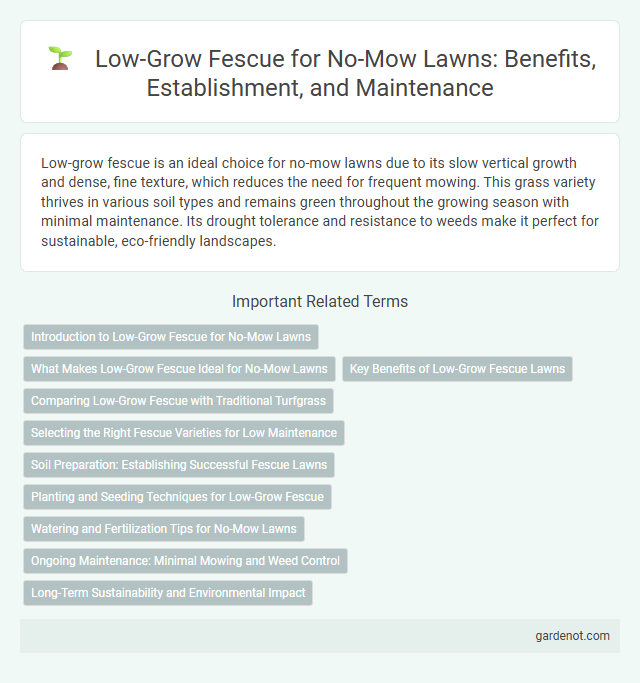Low-grow fescue is an ideal choice for no-mow lawns due to its slow vertical growth and dense, fine texture, which reduces the need for frequent mowing. This grass variety thrives in various soil types and remains green throughout the growing season with minimal maintenance. Its drought tolerance and resistance to weeds make it perfect for sustainable, eco-friendly landscapes.
Introduction to Low-Grow Fescue for No-Mow Lawns
Low-grow fescue is a drought-tolerant grass variety ideal for no-mow lawns due to its slow growth rate and minimal maintenance requirements. Its fine-textured blades create a lush, dense turf that stays green longer and reduces the need for frequent watering or mowing. This eco-friendly grass variety supports sustainable landscaping by lowering water consumption and eliminating the use of lawn equipment emissions.
What Makes Low-Grow Fescue Ideal for No-Mow Lawns
Low-grow fescue is ideal for no-mow lawns due to its naturally slow growth rate, reducing the need for frequent trimming and maintenance. Its dense, fine-textured blades create a lush, carpet-like appearance that remains attractive without regular mowing. This drought-resistant grass also thrives in various soil types, making it perfect for sustainable, low-maintenance landscapes.
Key Benefits of Low-Grow Fescue Lawns
Low-grow fescue lawns require significantly less mowing, saving time and reducing maintenance costs. Their deep root systems enhance drought tolerance and improve soil health by preventing erosion. These grasses maintain a lush, green appearance year-round, promoting water conservation and providing a resilient, eco-friendly lawn option.
Comparing Low-Grow Fescue with Traditional Turfgrass
Low-grow fescue requires significantly less mowing frequency than traditional turfgrass, reducing maintenance efforts and costs. Its deep root system enhances drought tolerance and soil health, outperforming conventional turfgrass in water efficiency. Low-grow fescue also supports biodiversity by providing habitat for pollinators, unlike uniform traditional grass lawns.
Selecting the Right Fescue Varieties for Low Maintenance
Low-grow fescue varieties such as Chewings fescue and hard fescue provide excellent options for no-mow lawns due to their slow growth rate and drought tolerance. Selecting cultivars like 'Mystic' or 'Aurora' enhances low maintenance by reducing mowing frequency and water usage. These fescues establish a dense, fine-textured turf that suppresses weeds and thrives in shaded or sunny areas with minimal care.
Soil Preparation: Establishing Successful Fescue Lawns
For successful low-grow fescue lawns, soil preparation involves testing pH levels to maintain an optimal range of 5.5 to 6.5 for nutrient availability. Incorporate organic matter such as compost to improve soil structure and drainage, ensuring robust root development. Proper soil aeration and loosening before seeding promote seed-to-soil contact, enhancing germination rates and overall lawn establishment.
Planting and Seeding Techniques for Low-Grow Fescue
Planting low-grow fescue requires choosing high-quality seed blends suited for no-mow lawns to ensure dense, uniform coverage. Seeding techniques emphasize shallow soil contact and consistent moisture to enhance germination rates, with preferred methods including slit seeding or broadcast spreading followed by light rolling. Optimal seeding times are early fall or spring when soil temperatures range between 50-65degF, maximizing establishment and reducing weed competition.
Watering and Fertilization Tips for No-Mow Lawns
Low-grow fescue thrives with deep, infrequent watering to promote drought resistance and reduce water waste in no-mow lawns. Apply a balanced, slow-release fertilizer in early spring and mid-fall to maintain steady nutrient availability and support dense, healthy growth. Avoid high nitrogen levels that encourage rapid growth, keeping maintenance minimal and preserving the no-mow lawn benefits.
Ongoing Maintenance: Minimal Mowing and Weed Control
Low-grow fescue requires minimal mowing, typically once or twice per season, which significantly reduces maintenance time compared to traditional lawns. Its dense growth habit suppresses weed emergence, lowering the need for herbicide applications. Routine monitoring and occasional spot weeding ensure a healthy, low-maintenance no-mow lawn.
Long-Term Sustainability and Environmental Impact
Low-grow fescue enhances long-term sustainability by requiring minimal mowing, which reduces fossil fuel consumption and carbon emissions. Its deep root system improves soil health and water retention, decreasing irrigation needs and promoting biodiversity. This eco-friendly grass choice contributes to a resilient, low-maintenance lawn that supports environmental conservation goals.
Low-grow fescue Infographic

 gardenot.com
gardenot.com